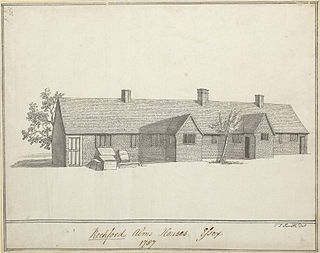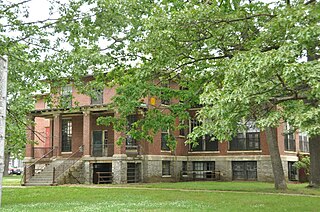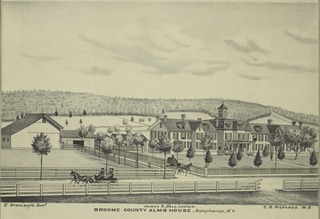
Harrisburg is a city in and the county seat of Saline County, Illinois, United States. It is located about 57 miles southwest of Evansville, Indiana and 111 mi (179 km) southeast of St. Louis, Missouri. The 2010 population was 9,017, and the surrounding Harrisburg Township had a population of 10,790, including the city residents. Harrisburg is included in the Illinois–Indiana–Kentucky tri-state area and is the principal city in the Harrisburg Micropolitan Statistical Area with a combined population of 24,913.

An almshouse is charitable housing provided to people in a particular community. They are often targeted at the poor of a locality, at those from certain forms of previous employment, or their widows, and at elderly people who can no longer pay rent, and are generally maintained by a charity or the trustees of a bequest. Almshouses were originally formed as extensions of the church system and were later adapted by local officials and authorities.

A poorhouse or workhouse is a government-run facility to support and provide housing for the dependent or needy.

Tewksbury Hospital is a National Register of Historic Places-listed site located on an 800+ acre campus in Tewksbury, Massachusetts. The centerpiece of the hospital campus is the 1894 Richard Morris Building.

Lincoln Boyhood National Memorial is a United States presidential memorial and a National Historic Landmark District in Lincoln City, Indiana. It preserves the farm site where Abraham Lincoln lived with his family from 1816 to 1830. During that time, he grew from a 7-year-old boy to a 21-year-old man. His mother, Nancy Hanks Lincoln, and at least 27 other settlers were buried here in the Pioneer Cemetery. His sister Sarah Lincoln Grigsby was buried in the nearby Little Pigeon Baptist Church cemetery, across the street at Lincoln State Park.

Harrisburg State Hospital, formerly known as Pennsylvania State Lunatic Hospital from 1851 to 1937, in Harrisburg, Pennsylvania, Dauphin County, on Cameron and Maclay Streets, was Pennsylvania's first public facility to house the mentally ill and disabled.

The Greene County Almshouse is a historic poorhouse located in Greene County, Illinois, along a township road northeast of the city of Carrollton. The almshouse was built in 1870 in accordance with an 1839 state law which provided for each county to establish its own almshouse or poor farm for welfare recipients. Prior to passage of the law, public welfare in Illinois had taken the form of "outdoor relief", in which the poor worked on farms in exchange for basic support. Under Illinois' county almshouse system, the poor were intended to receive shelter and necessities in the houses, often in exchange for farm labor on the property. By 1903, all but two of Illinois' counties had established an almshouse or poor farm.

Millville is a defunct settlement in Jo Daviess County, Illinois, United States, located within the boundaries of Apple River Canyon State Park. Founded in 1835 and platted in 1846, the community was washed away completely by a flood in 1892. No visible remnants of its structures remain today. The site of Millville was added to the U.S. National Register of Historic Places as the Millville Town Site in 2003.

The Almshouse is an historic almshouse located at 45 Matignon Road in Cambridge, Massachusetts. It is now the site of the International School of Boston's main campus. It was built in 1850, and is a prominent example of institutional residential architecture in stone, resembling prisons of the era. The building was added to the National Register of Historic Places in 1982, where it is incorrectly listed at 41 Orchard Street.

The Wrentham Developmental Center, formerly Wrentham State School, is a historic state-run medical facility for the treatment of psychiatric and developmental disorders. It is located on a large campus at the junction of Emerald and North Streets in Wrentham, Massachusetts. The school was authorized by the state in 1906, and the first phase of the campus was developed between 1909 and 1917. The school opened in 1910. The school had a typical patient population of 1,200-1,300 during the 1920s. The name was changed in the 1990s. The school campus was added to the National Register of Historic Places in 1994.

The Monson Developmental Center was a Massachusetts state facility in Monson, Massachusetts. The property, whose core has been in state control since 1854, historically housed a variety of facilities for providing services to the indigent or sick. It was closed in 2012, and the state is soliciting bids for sale and reuse of the developed portions of the property.

Carroll County Almshouse and Farm, also known as the Carroll County Farm Museum, is a historic farm complex located at Westminster, Carroll County, Maryland. It consists of a complex of 15 buildings including the main house and dependencies. The 30-room brick main house was originally designed and constructed for use as the county almshouse. It is a long, three-story, rectangular structure, nine bays wide at the first- and second-floor levels of both front and rear façades. It features a simple frame cupola sheltering a farm bell. A separate two-story brick building with 14 rooms houses the original summer kitchen, wash room, and baking room, and may have once housed farm and domestic help. Also on the property is a brick, one-story dairy with a pyramidal roof dominated by a pointed finial of exaggerated height with Victorian Gothic "icing" decorating the eaves; a large frame and dressed stone bank barn; and a blacksmith's shop, spring house, smokehouse, ice house, and numerous other sheds and dependencies all used as a part of the working farm museum activities. The original Carroll County Almshouse was founded in 1852 and the Farm Museum was established in 1965.

Edgemoor Farm Dairy Farm was built as part of a dairy farm in 1913 in Santee, California. Edgemoor was part of a Spanish land grant to Maria Antonio Estudillo who married Miguel de Pedrorena, a native of Madrid. By the 1850s, through a variety of ways, individuals obtained portions of the grant and began to farm. Walter Hamlin Dupee purchased Edgemoor Farm in 1913 and built it into a national award-winning dairy farm, polo pony ranch and early tourist attraction.

Almshouse Farm at Machipongo, now known as the Barrier Islands Center, is a historic almshouse for African-Americans located at Machipongo, Northampton County, Virginia. The oldest of the three main buildings was built about 1725, and is a 1 1/2-half story structure built in two parts, one brick and one frame, and probably predates the almshouse use of the property. The main building was built about 1840, and is a frame, two-story building in the vernacular Greek Revival style. It housed residents of the almshouse farm. A building dated to 1910, is a one-story frame building in a form resembling that of one-story frame school buildings from the same period. Also on the property are two contributing small, frame, late-19 or early 20th-century outbuildings. The Northampton County Almshouse Farm was in continuous operation between 1803 and 1952.

Shenandoah County Farm, also known as the Shenandoah County Almshouse and Beckford Parish Glebe Farm, is a historic almshouse and poor farm located near Maurertown, Shenandoah County, Virginia. The almshouse was built in 1829, and is a large, brick Federal style institutional building. It consists of a two-story, five bay central section flanked by one-story, eight bay, flanking wings. A nearly identical building is at the Frederick County Poor Farm. A two-story, rear kitchen wing was added about 1850. Also on the property are the contributing stone spring house, a large modern frame barn (1952), a frame meat house (1894), a cemetery, and a portion of an American Civil War encampment site, occupied by Union troops prior to the Battle of Tom's Brook.

The Illinois Salines, also known as the Saline Springs or Great Salt Springs, is a salt spring site located along the Saline River in Gallatin County, Illinois. The site was a source of salt for Illinois' prehistoric settlers and is now an archaeological site with a large quantity of organic remains. After European settlement of Illinois, the salt springs became part of Illinois' first major industry and were one of the only places in Illinois where slavery was legal after 1818.

The Broome County Alms House, was located in the town of Dickinson, three miles north of Binghamton in Broome county, New York. The red brick building operated as a shelter for the poor, take care of the sick, disabled, mentally unwell, widowed, and orphaned persons in the community until c. 1960. The goal of the almshouse was to both help break the cycle of poverty and to care for members of the community who had no means of caring take of themselves. The building was demolished on February 5, 2010.

The Oliver Whiting Homestead is a historic farmstead on Old County Farm Road in Wilton, New Hampshire, just south of the County Farm Bridge. The 72-acre (29 ha) property was one of the region's largest dairy farms in the early 19th century, and it was used as Hillsborough County's poor farm between 1867 and 1896. The main focus of the property is a large Federal-style brick house built c. 1800 by Oliver Whiting; it also has an 1846 Gothic Revival barn which predates the establishment of the poor farm. The property was listed on the National Register of Historic Places in 1982.

The Strafford County Farm is a complex of buildings in Dover, New Hampshire, historically associated with the management of the poor and criminals of Strafford County. A significant portion of the farm is now taken up by the modern Strafford County Jail, but several historic buildings survive on the campus, which were listed on the National Register of Historic Places in 1981. These include the 1881 almshouse and the 1907 county jail.

The Malden City Infirmary is a historic municipal facility at 341 Forest Street in Malden, Massachusetts. Established by the city in the 18th century as a poor farm, the surviving elements of the property include the 1870 Warden's House, and the 1933 infirmary, which continues to serve as an elderly care and nursing facility known as Forestdale Senior Living. The property was listed on the National Register of Historic Places in 2020.






















